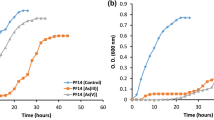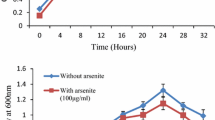Abstract
Multiple heavy metal–resistant bacterium, Micrococcus luteus strain AS2, was isolated from industrial waste water of District Sheikhupura, Pakistan. The isolated bacterium showed minimum inhibitory concentrations of 55 and 275 mM against arsenite and arsenate. The bacterial strain also showed resistance against other heavy metal ions, i.e., lead, cadmium, chromium, mercury, nickel, and zinc, apart from arsenic. The optimum temperature and pH were 37 °C and 7, respectively. The antioxidant enzymes such as catalase were significantly increased under arsenite stress. The increase in 43.9% of GSH/GSSG and 72.72% of non-protein thiol was determined under15 mM arsenite stress. Bacterial genome was sequenced through Illumina and Nanopore and genes related to arsenic and other heavy metals were identified and blast (tblastx) on NCBI. Through scanning electron microscopy, no morphological changes were observed in bacterial cells under arsenite stress. The peaks appeared in EDX showed that there is surface adsorption of arsenite in bacterial cell while it was confirmed from Fourier transformed infrared spectroscopy analysis that there is some interaction between arsenite and functional groups present on the surface of bacterial cell. The SDS-PAGE analysis of whole-cell proteins under 15 mM arsenite stress clearly revealed that there is upregulation of some proteins in ranged of 60 to 34 kDa. The bioremediation efficiency (E) of bacterial biomass was 72% after 2 h and 99% after 10 h. The bioremediation efficiency of bacterial biomass is an indicator for the isolated bacterium to employ as a potential candidate for the amelioration of sites contaminated with arsenic.







Similar content being viewed by others
References
Achour AR, Bauda P, Billard P (2007) Diversity of arsenite transporter genes from arsenic-resistant soil bacteria. Res Microbiol 158:128–137
Banerjee S, Datta S, Chattyopadhyay D, Sarkar P (2011) Arsenic accumulating and transforming bacteria isolated from contaminated soil for potential use in bioremediation. J Environ Sci Health A 46:1736–1747
Biswas R, Sarkar A (2019) Characterization of arsenite-oxidizing bacteria to decipher their role in arsenic bioremediation. Prep Biochem Biotechnol 49:30–37
Bobrowicz P, Wysocki R, Owsianik G, Goffeau A, Ułaszewski S (1997) Isolation of three contiguous genes, ACR1, ACR2 and ACR3, involved in resistance to arsenic compounds in the yeast Saccharomyces cerevisiae. Yeast 13:819–828
Branco R, Francisco R, Chung AP, Morais PV (2009) Identification of an aox system that requires cytochrome c in the highly arsenic-resistant bacterium Ochrobactrum tritici SCII24. Appl Environ Microbiol 75:5141–5147
Butcher BG, Deane SM, Rawlings DE (2000) The chromosomal arsenic resistance genes of Thiobacillus ferrooxidans have an unusual arrangement and confer increased arsenic and antimony resistance to Escherichia coli. Appl Environ Microbiol 66:1826–1833
Cai L, Liu G, Rensing C, Wang G (2009) Genes involved in arsenic transformation and resistance associated with different levels of arsenic-contaminated soils. BMC Microbiol 9:4
Cánovas D, Cases I, De Lorenzo V (2003) Heavy metal tolerance and metal homeostasis in Pseudomonas putida as revealed by complete genome analysis. Environ Microbiol 5:1242–1256
Chen J, Qin J, Zhu Y-G, de Lorenzo V, Rosen BP (2013) Engineering the soil bacterium Pseudomonas putida for arsenic methylation. Appl Environ Microbiol 79:4493–4495
Chong TM, Yin W-F, Chen J-W, Mondy S, Grandclément C, Faure D, Dessaux Y, Chan K-G (2016) Comprehensive genomic and phenotypic metal resistance profile of Pseudomonas putida strain S13. 1.2 isolated from a vineyard soil. AMB Express 6:95
Fagan MJ, Saier MH (1994) P-type ATPases of eukaryotes and bacteria: sequence analyses and construction of phylogenetic trees. J Mol Evol 38:57–99
Islam S, Rahman MM, Naidu R (2019) Impact of water and fertilizer management on arsenic bioaccumulation and speciation in rice plants grown under greenhouse conditions. Chemosphere 214:606–613
Cappuccino JG, Sherman N (2002) Microbiology: a laboratory manual, 6th ed. Pearson Education, Inc., California, USA
Jia M-R, Tang N, Cao Y, Chen Y, Han Y-H, Ma LQ (2019) Efficient arsenate reduction by As-resistant bacterium Bacillus sp. strain PVR-YHB1-1: characterization and genome analysis. Chemosphere 218:1061–1070
Jobby R, Shah K, Shah R, Jha P, Desai N (2016) Differential expression of antioxidant enzymes under arsenic stress in Enterobacter sp. Environ Prog Sustain Energy 35:1642–1645
Joynt J, Bischoff M, Turco R, Konopka A, Nakatsu CH (2006) Microbial community analysis of soils contaminated with lead, chromium and petroleum hydrocarbons. Microb Ecol 51:209–219
Karelová E, Harichová J, Stojnev T, Pangallo D, Ferianc P (2011) The isolation of heavy-metal resistant culturable bacteria and resistance determinants from a heavy-metal-contaminated site. Biologia 66:18–26
Kumari P, Rastogi A, Shukla A, Srivastava S, Yadav S (2018) Prospects of genetic engineering utilizing potential genes for regulating arsenic accumulation in plants. Chemosphere 211:397–406
Liu SX, Athar M, Lippai I, Waldren C, Hei TK (2001) Induction of oxyradicals by arsenic: implication for mechanism of genotoxicity. Proc Natl Acad Sci U S A 98:1643–1648
Luck H (1974) In: Bergmeyer HU, Gawhn K (eds) Methods in enzymatic analysis. Academic Press, New York, pp 885–894
Manzoor M, Abid R, Rathinasabapathi B, De Oliveira LM, da Silva E, Deng F, Rensing C, Arshad M, Gul I, Xiang P (2019) Metal tolerance of arsenic-resistant bacteria and their ability to promote plant growth of Pteris vittata in Pb-contaminated soil. Sci Total Environ 660:18–24
Marklund S, Marklund G (1974) Involvement of the superoxide anion radical in the autoxidation of pyrogallol and a convenient assay for superoxide dismutase. Eur J Biochem 47:469–474
Mondal M, Biswas JK, Tsang YF, Sarkar B, Sarkar D, Rai M, Sarkar SK, Hooda PS (2019) A wastewater bacterium Bacillus sp. KUJM2 acts as an agent for remediation of potentially toxic elements and promoter of plant (Lens culinaris) growth. Chemosphere 232:439–452
Mujawar SY, Shamim K, Vaigankar DC, Dubey SK (2019) Arsenite biotransformation and bioaccumulation by Klebsiella pneumoniae strain SSSW7 possessing arsenite oxidase (aioA) gene. BioMetals 32:65–76
Naureen A, Rehman A (2016) Arsenite oxidizing multiple metal resistant bacteria isolated from industrial effluent: their potential use in wastewater treatment. World J Microbiol Biotechnol 32:133
Prasad KS, Ramanathan A, Paul J, Subramanian V, Prasad R (2013) Biosorption of arsenite (As+3) and arsenate (As+5) from aqueous solution by Arthrobacter sp. biomass. Environ Technol 34:2701–2708
Rahman MM, Asaduzzaman M, Naidu R (2011) Arsenic exposure from rice and water sources in the Noakhali district of Bangladesh. Water Qual Expo Health 3:1–10
Ratkevicius N, Correa J, Moenne A (2003) Copper accumulation, synthesis of ascorbate and activation of ascorbate peroxidase in Enteromorpha compressa (L.) Grev.(Chlorophyta) from heavy metal-enriched environments in northern Chile. Plant Cell Environ 26:1599–1608
Reddy KJ, Wang L, Gloss SP (1995) Solubility and mobility of copper, zinc and lead in acidic environments. Plant Soil 171:53–58
Shah AH, Shahid M, Khalid S, Shabbir NZ, Bakhat HF, Murtaza B, Farooq A, Akram M, Shah GM, Nasim W, Niazi NK (2019) Assessment of arsenic exposure by drinking well water and associated carcinogenic risk in peri-urban areas of Vehari. Pakistan Environ Geochem Health. https://doi.org/10.1007/s10653-019-00306-6
Shakoor M, Niazi N, Bibi I, Rahman M, Naidu R, Dong Z, Shahid M, Arshad M (2015) Unraveling health risk and speciation of arsenic from groundwater in rural areas of Punjab, Pakistan. Int J Environ Res Public Health 12:12371–12390
Shakoor MB, Niazi NK, Bibi I, Murtaza G, Kunhikrishnan A, Seshadri B, Shahid M, Ali S, Bolan NS, Ok YS (2016) Remediation of arsenic-contaminated water using agricultural wastes as biosorbents. Crit Rev Environ Sci Technol 46:467–499
Shakoori FR, Aziz I, Rehman A, Shakoori A (2010) Isolation and characterization of arsenic reducing bacteria from industrial effluents and their potential use in bioremediation of wastewater. Pakistan J Zool 42:331–338
Shamim S, Rehman A (2015) Antioxidative enzyme profiling and biosorption ability of Cupriavidus metallidurans CH34 and Pseudomonas putida mt2 under cadmium stress. J Basic Microbiol 55:374–381
Sher S, Rehman A (2019) Use of heavy metals resistant bacteria-a strategy for arsenic bioremediation. Appl Microbiol Biotechnol 103:6607-6021
Singh N, Gupta S, Marwa N, Pandey V, Verma PC, Rathaur S, Singh N (2016) Arsenic mediated modifications in Bacillus aryabhattai and their biotechnological applications for arsenic bioremediation. Chemosphere 164:524–534
Smith AH, Lopipero PA, Bates MN, Steinmaus CM (2002) Public health. Arsenic epidemiology and drinking water standards. Science 296: 2145-2146
Tariq A, Ullah U, Asif M, Sadiq I (2019) Biosorption of arsenic through bacteria isolated from Pakistan. Int Microbiol 22:59–68
Tseng C-H, Tseng C-P, Chiou H-Y, Hsueh Y-M, Chong C-K, Chen C-J (2002) Epidemiologic evidence of diabetogenic effect of arsenic. Toxicol Lett 133:69–76
Wu Y, Feng S, Li B, Mi X (2010) The characteristics of Escherichia coli adsorption of arsenic (III) from aqueous solution. World J Microbiol Biotechnol 26:249–256
Wysocki R, Bobrowicz P, Ułaszewski S (1997) The Saccharomyces cerevisiae ACR3 gene encodes a putative membrane protein involved in arsenite transport. J Biol Chem 272:30061–30066
Yan G, Chen X, Du S, Deng Z, Wang L, Chen S (2019) Genetic mechanisms of arsenic detoxification and metabolism in bacteria. Curr Genet 65:329–338
Zhang W, Cui X, Gao Y, Sun L, Wang J, Yang Y, Liu X, Li Y, Guo X, Sun D (2019) Role of pigment epithelium-derived factor (PEDF) on arsenic-induced neuronal apoptosis. Chemosphere 215:925–931
Funding
The Higher Education Commission (HEC) provided funds to the first author to visit Denmark under IRSIP program.
Author information
Authors and Affiliations
Corresponding author
Ethics declarations
Conflict of interest
The authors declared that they have no conflict of interest.
Ethical statement
This article does not contain any studies with human participants or animals performed by any of the authors.
Additional information
Publisher’s note
Springer Nature remains neutral with regard to jurisdictional claims in published maps and institutional affiliations.
Electronic supplementary material
ESM 1
(PDF 449 kb)
Rights and permissions
About this article
Cite this article
Sher, S., Hussain, S.Z. & Rehman, A. Phenotypic and genomic analysis of multiple heavy metal–resistant Micrococcus luteus strain AS2 isolated from industrial waste water and its potential use in arsenic bioremediation. Appl Microbiol Biotechnol 104, 2243–2254 (2020). https://doi.org/10.1007/s00253-020-10351-2
Received:
Revised:
Accepted:
Published:
Issue Date:
DOI: https://doi.org/10.1007/s00253-020-10351-2




